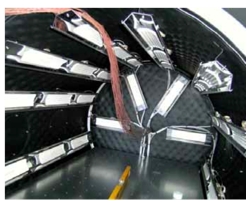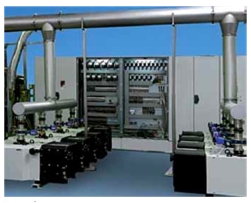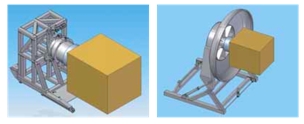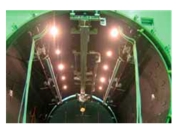APPLICATIONS FROM ANGELANTONI INDUSTRIES:
PART ONE - AEROSPACE
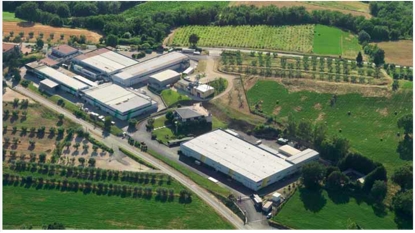 Since 1952 Angelantoni Industries have been producing and marketing worldwide, under the ACS brand, environmental test chambers for all types of tests on materials, components, and finished products. The ACS brand has always been associated with vast experience and flexibility in customized solutions, and with undisputed expertise in technologies, gained in part through close co-operation with research institutions, universities, and industrial partners. The ACS brand has acquired a strong leadership position in the aerospace sectors, the most challenging environment for simulation: after the first space simulator in 1988, Angelantoni Industries became one of the few leader manufacturers at international level, and a supplier for the most important space research centers testing satellites, subsystems and components. With the acquisition of two companies, in France and in Germany, the testing sector currently consists of 3 business units:
Since 1952 Angelantoni Industries have been producing and marketing worldwide, under the ACS brand, environmental test chambers for all types of tests on materials, components, and finished products. The ACS brand has always been associated with vast experience and flexibility in customized solutions, and with undisputed expertise in technologies, gained in part through close co-operation with research institutions, universities, and industrial partners. The ACS brand has acquired a strong leadership position in the aerospace sectors, the most challenging environment for simulation: after the first space simulator in 1988, Angelantoni Industries became one of the few leader manufacturers at international level, and a supplier for the most important space research centers testing satellites, subsystems and components. With the acquisition of two companies, in France and in Germany, the testing sector currently consists of 3 business units:
Environmental Test Chamber (ACS brand)
Electrodynamics shakers (TIRA brand)
Test benches and crash test systems for the automotive and aerospace sector (BIA brand)
Today the Angelantoni Group boasts 8 production plants located in Italy, Germany, France, India and China with a total of over 800 employees.
International cooperation among the world's space agencies has grown with the birth of new economic powers. New partners mean an increased availability of funds and the possibility for more ambitious missions, bringing new life to the aerospace business sector.
In addition to the growing demand for global communication, public awareness has also increased in regard to the need to defend our planet from environmental degradation. Population growth has also led the major space agencies to push forward more ambitious programs, which even include a manned mission to Mars by 2030.
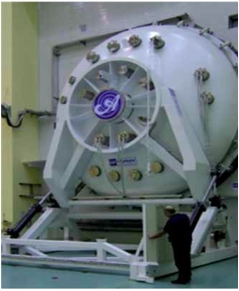 Angelantoni has been an active supplier in the aerospace Industry for over 20 years, as a producer and suppler of complete systems for environmental simulation testing. For example, Angelantoni space simulators are used to test components, subsystems, and complete satellites. The most common application of the space simulator are related to the testing of satellites in a thermal vacuum chamber, which involves the simultaneous control of two environmental parameters: Pressure and temperature.
Angelantoni has been an active supplier in the aerospace Industry for over 20 years, as a producer and suppler of complete systems for environmental simulation testing. For example, Angelantoni space simulators are used to test components, subsystems, and complete satellites. The most common application of the space simulator are related to the testing of satellites in a thermal vacuum chamber, which involves the simultaneous control of two environmental parameters: Pressure and temperature.
Features and Benefits
- Wide range of chamber sizes, with diameters ranging from under 1m up to 10m
- High quality and vast experience in vacuum pumping systems
- High quality of black shroud paint with a solution for low out gassing at maximum temperatures (>+150°C) according to ESA standard ECSS-Q-ST-70-02C
- Special attention to minimizing consumption through hardware solutions and software management of the plant
- Integrated control and monitoring system totally developed by ACS
- Special attention to and experience in redundancy aspects
- Full capability for supplying turnkey systems
Satellite Testing
 Thermal cycling: used to subject the DUT (Device Under Test) to the alternation of high and low temperatures within a temperature range that is typically -100°C to +100°C, while the pressure is maintained at values below 10-6 mbar 9high vacuum). While the satellite is subjected to thermal cycling, it is possible for RF (radio frequency) signals to be exchanged across the chamber through dedicated wave-guides. These tests may take up to a month.
Thermal cycling: used to subject the DUT (Device Under Test) to the alternation of high and low temperatures within a temperature range that is typically -100°C to +100°C, while the pressure is maintained at values below 10-6 mbar 9high vacuum). While the satellite is subjected to thermal cycling, it is possible for RF (radio frequency) signals to be exchanged across the chamber through dedicated wave-guides. These tests may take up to a month.
Thermal balance: made for the validation of the thermal mathematical model of the satellite. Test are performed by creating an environment with a temperature range similar to that which the satellite will encounter while in orbit) below -180°C). Some parts of the satellite are also subjected to heating from the hot sources) lamps or IR emitters) to simulate the effect of the sunrays which can cause temperatures to locally reach +150°C. The satellite is kept at a constant pressure of 10-6 mbar during these tests.
A wide range of thermal systems is available based on different needs, economy and flexibility for example:
- Liquid nitrogen flooding (boiling mode)
- Liquid nitrogen flooding (boiling mode) with heating elements (lamps or IR emitters)
- Liquid nitrogen partial flooding (boiling mode) with heating elements (lamps or IR emitters)
- Liquid nitrogen pressurized circuit with heating elements (lamps or IT emitters)
- Pressurized gaseous nitrogen circuit
- Combined liquid and gaseous nitrogen modes
- Mechanical cooling with intermediate fluids
Construction
A space simulation chamber can be broken down into 4 main parts:
The vessel - produced from high-quality steel, is the external structure of the testing area and is capable of withstanding the pressure differences between the internal and external environments. Inside the chamber there is an enclosed area in which the tests are carried out. It consists of a cylindrical body, which, at one end, has a large door-shaped concave disc for accessing the objects to be tested. A cylindrical heat shield, the shroud is placed within the vessel. This permits adjusting the temperature inside the test area. The DUT is placed in the center of the test are to ensure proper radiation at the specified temperatures. Two disc-shaped heat shields close the two ends of the cylindrical body completely, so as to achieve a uniform temperature field around the specimen. The shroud consists of two laminated sheets with a space of a few millimeters between them. The space is used for the passage of the fluid heat carrier from the thermal power generation system.
The thermal system - is located near the room and consists of all components (pumps, valves, heat exchangers, sensors) necessary for changing the temperature of the fluid heat carrier. This system is connected to the shroud through super insulated pipes that pass through the walls of the vessel. The fluid heat carriers are typically liquid and gaseous nitrogen, but in some applications special oils can be used.
The vacuum generation plant - consists of a set of vacuum pumps, whose main function is to extract air from the chamber to obtain and maintain the vacuum. There are two stages of pumping: the first stage, called primary or rough pumping, allows the transition from ambient pressure to values of around 10-2 mbar, necessary to trigger the operation of the second stage, consisting of more sophisticated pumps (cryogenic pumps) that allow the achievement of a high vacuum.
Typical levels of final pressure inside the chamber are around 1x10-6 mbar, but can drop to values in the range of 10-8 mbar.
The control and management system - of the space simulation chamber consists of a set of electrical cabinets for the power distribution and for the PLC-based control of the chamber subsystems.
The data acquisition system and the SW PC board provide the main user interface and the direct mans for controlling and monitoring the whole chamber.

